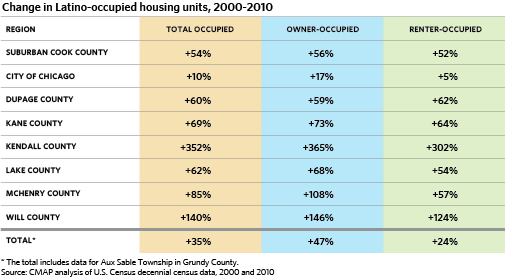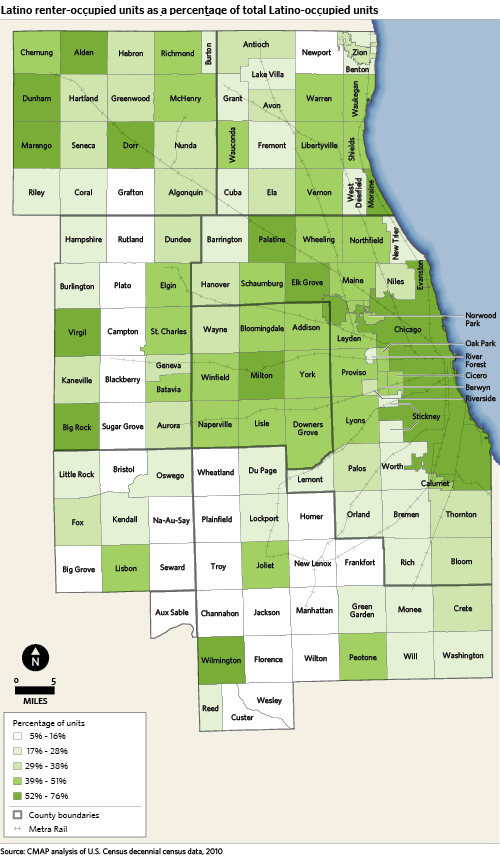Earlier this year, a CMAP Policy Update examined how Latino population growth over the past decade has driven metropolitan Chicago's overall population growth. Between 2000 and 2010, the region's Latino population grew 29.5 percent while the region's overall population grew 3.6 percent. The Latino population now makes up 21.6 percent of the region's population (up from 17.2 percent in 2000). The growth in Latino residents was actually greater than the region's overall population growth by 122,263 residents. Without this growth, many communities in the region would have lost population, which would have had a serious effect on their ability to attract and retain businesses and local tax dollars.
This growth has many implications for our communities. Published in mid-2008, CMAP's Latinos in Our Region snapshot report describes how Latino population growth could affect employment and education, transportation, housing, and other quality of life issues. These new residents often come with distinct needs and preferences in terms of housing types, education, and other services. Moving forward, many communities in the region may confront challenges associated with mutual integration and communication with all members of the community. This Policy Update expands on the earlier one, using new Census 2010 data released on August 4, 2011.
Latino Population Demographics, 2000 to 2010
Latino population growth has outpaced population growth in the region as a whole. The table below illustrates the overall and Latino population changes by county and in the City of Chicago. In Cook and DuPage counties, net growth in the Latino population was greater than net growth in the population as a whole. In particular, Latino growth in DuPage County was three times that of the county's overall population growth, and in suburban Cook it was eight times overall population growth. Similar to the region as a whole, population in these areas would have declined without growth in the Latino population.
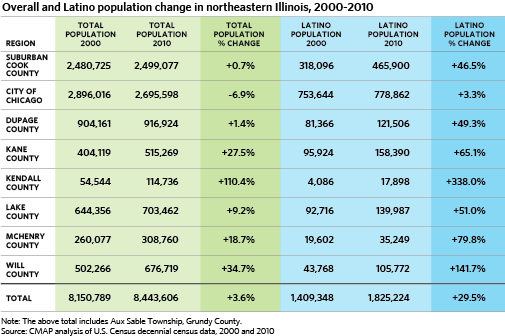
The significant growth of the Latino population as compared to overall population impacts the proportion of the population that is Latino. As shown below, all counties in the region experienced a growth in this measure. Growth was most pronounced in the counties that are also the fastest growing overall. Kendall County's proportion of the population that is Latino doubled, and Will County's proportion nearly doubled. Although Kane County's population also grew at a higher rate, its proportion of population that is Latino changed to a lesser extent, increasing by about one third. The table below provides the 2000 and 2010 Latino proportion of the population for all counties in the region.
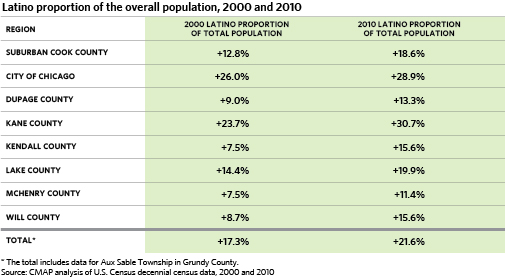
While the county-by-county summaries above provide some indication of the larger changes in the proportion of Latino population in the region, these changes appear to be concentrated in some areas more than others. In particular, older suburban communities directly west of Chicago and several communities in the collar counties experienced significant growth in the Latino percentage of the overall population. These changes are depicted in the map below.
Finally with regard to population, Latinos now represent a majority or significant percentage of the population in several communities and townships in the region. The map below depicts the Latino percentage of the population by township.
Latino Age Demographics
Recently, CMAP's Policy Updates explored trends in the senior population of northeastern Illinois, and how the senior population (residents age 65 and older) has grown at a faster rate than the overall population. The most recent U.S. Census data release indicates that the Latino population was a major driver of the growth in the senior population over the past decade. While the growing senior population presents challenges with providing access to appropriate housing and addressing transportation needs, the growing Latino senior population may present its own unique challenges to the region. As discussed in CMAP's Latinos in Our Region snapshot, Latinos make up 25 percent of neighborhoods with high transportation and high housing costs. This may be a concern for sustaining Latino residents' ability to "age in place" — to remain in their homes and communities, as they age, if they choose.
For both Latinos and overall, the senior population grew faster than the population under age 64. The following chart shows that while the region's Latino population grew by 29.5 percent, the senior population grew by 69.1 percent, from 44,484 residents in 2000 to 75,203 residents in 2010.

Latino seniors were also the largest contributor to the region's overall senior population growth. In 2010, Latinos made up 21.6 percent of the region's population but accounted for 39.8 percent of the growth in the region's senior population. In addition to Latinos, Asians and Blacks or African Americans were also large contributors toward the 77,184 increase in the region's senior population. Despite the increase in seniors, the region's Black or African American population actually experienced a decrease overall. The following chart illustrates how these demographic groups contributed toward the region's senior population increase.
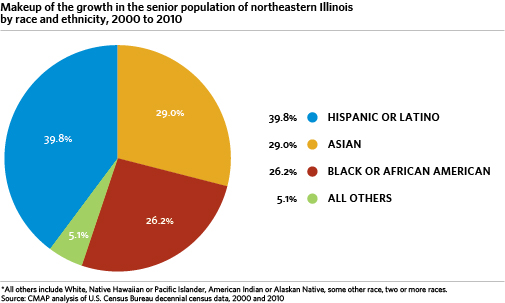
Overall, the region's Latino population still remains younger than the region's overall population. In 2010, Latino residents under the age of 20 made up 38.8 percent of the Latino population, while overall, residents under the age of 20 made up 27.8 percent of the population. However, the Latino population's age distribution is trending older, resulting in seniors making up 4.1 percent of the population in 2010, up from 3.2 percent in 2000. At the same time, seniors made up 11.3 percent of the overall 2010 population, up from 10.7 percent in 2000. The following chart compares the Latino population in 2000 and 2010 with the overall population, by age group.
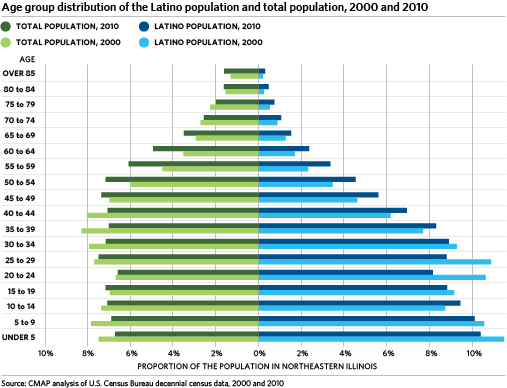
Housing and the Latino Population in Northeastern Illinois
As described in a previous Policy Update, about 65.5 percent of all occupied units are owned by their occupants, with the remaining 34.5 percent of occupied units rented. As one of the fastest-growing demographic groups in the region, Latino residents bear special mention with regard to housing tenure. Forty-six percent of all housing units occupied by Latino householders are located in the City of Chicago, and an additional 25 percent are located in suburban Cook County. Just under half (48 percent) of all Latino-occupied housing units are rented, with a higher proportion of renter-occupied units in the City of Chicago (58 percent). In Will County, 24 percent of Latino-occupied housing units are renter-occupied, and in Kendall County, 18 percent are renter-occupied. The distribution of Latino-occupied housing, both rented and owned, corresponds to the distribution of Latino population as mapped in the Latinos in Our Region snapshot report.
Latino-occupied housing represents a large share of the region's rented units. While Latino-occupied housing units account for 20 percent of the total in Chicago and 12 percent of the total in suburban Cook County, Latino renter-occupied units account for 21 percent and 19 percent of the total, respectively. This disparity grows in the collar counties. In Kane County, for example, Latino-occupied units account for 21 percent of total occupied units, while Latino-rented units account for 34 percent of total rented units.
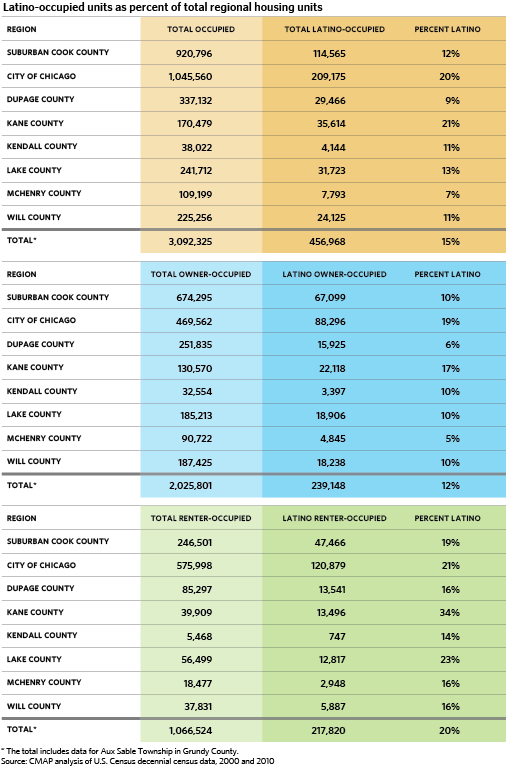
Renter-occupied housing represents the majority of Latino-occupied housing in the City of Chicago. The same trend holds true in several suburban townships with relatively little rental housing, both in the middle and outer rings of the metropolitan area. In these townships, most Latinos live in rented housing units. Between 39 percent and 51 percent of Latinos live in rental housing in townships across DuPage County, northern Cook County, and eastern Lake County.
Over the past decade, all counties experienced growth in Latino-occupied housing units, including both owner-occupied and renter-occupied. Kendall County experienced substantial growth -- more than 300 percent for all categories -- although it started from a relatively small base. Nevertheless, populous DuPage and suburban Cook Counties registered 50 to 60 percent increases in Latino-occupied housing units. Chicago experienced lower growth rates than any county, suggesting some suburbanization of the region's Latino-occupied housing units. Additionally, growth in Latino owner-occupied housing surpassed that of Latino renter-occupied housing in all counties but DuPage. For the region as a whole, the growth rate for Latino owner-occupied housing was almost double that of Latino renter-occupied housing (47 and 24 percent, respectively), which may suggest increasing home ownership among the region's Latino community.
